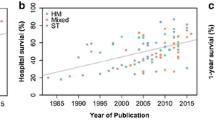Abstract
Objective
The decision to start chemotherapy in critically ill cancer patients is extremely complex in the intensive care unit (ICU). Therefore, this study evaluated the outcomes and prognostic factors in critically ill cancer patients receiving chemotherapy in the ICU.
Methods
A retrospective analysis was performed using 62 cancer patients who received chemotherapy in the ICU between October 2002 and December 2008. The dataset included 49 hematologic malignancies (79%) and 13 solid tumors (21%).
Results
Twenty (32%) patients were admitted to the ICU with septic shock, 15 (24%) with respiratory failure, and 14 (23%) with renal failure. The median SOFA and SAPS II scores at the time of chemotherapy were 10 (interquartile range, 6–14) and 53 (interquartile range, 41–68), respectively. Twenty-three (37%) patients had concomitant infections when chemotherapy was initiated. Thirty-eight (61%) patients received mechanical ventilation, and 19 (31%) patients underwent renal replacement therapy at the moment of chemotherapy. Overall, 25 (40%) patients died in the ICU; death occurred due to septic shock (13, 52%), cancer progression (9, 36%), or bleeding (2, 8%). ICU mortality after chemotherapy was correlated with respiratory failure requiring mechanical ventilation (OR, 6.26; 95% CI, 1.12–34.95) and a SOFA score of ≥10 (OR, 9.66; 95% CI, 1.43–65.47) upon initiating chemotherapy.
Conclusions
Chemotherapy in the ICU for critically ill cancer patients can be considered even when infection or organ failure is present. However, the severity of organ failure, including respiratory failure requiring mechanical ventilation, was associated with an increased mortality after chemotherapy during an ICU stay.
Similar content being viewed by others
References
Schapira DV, Studnicki J, Bradham DD, Wolff P, Jarrett A (1993) Intensive care, survival, and expense of treating critically ill cancer patients. JAMA 269:783–786
Gelder MS (1995) Life and death decisions in the intensive care unit. Cancer 76:2171–2175
Azoulay E, Alberti C, Bornstain C, Leleu G, Moreau D, Recher C, Chevret S, Le Gall JR, Brochard L, Schlemmer B (2001) Improved survival in cancer patients requiring mechanical ventilatory support: impact of noninvasive mechanical ventilatory support. Crit Care Med 29:519–525
Larche J, Azoulay E, Fieux F, Mesnard L, Moreau D, Thiery G, Darmon M, Le Gall JR, Schlemmer B (2003) Improved survival of critically ill cancer patients with septic shock. Intensive Care Med 29:1688–1695
Moran JL, Solomon PJ, Williams PJ (2005) Assessment of outcome over a 10-year period of patients admitted to a multidisciplinary adult intensive care unit with haematological and solid tumours. Anaesth Intensive Care 33:26–35
Azoulay E, Afessa B (2006) The intensive care support of patients with malignancy: do everything that can be done. Intensive Care Med 32:3–5
Darmon M, Thiery G, Ciroldi M, de Miranda S, Galicier L, Raffoux E, Le Gall JR, Schlemmer B, Azoulay E (2005) Intensive care in patients with newly diagnosed malignancies and a need for cancer chemotherapy. Crit Care Med 33:2488–2493
Benoit DD, Depuydt PO, Vandewoude KH, Offner FC, Boterberg T, De Cock CA, Noens LA, Janssens AM, Decruyenaere JM (2006) Outcome in severely ill patients with hematological malignancies who received intravenous chemotherapy in the intensive care unit. Intensive Care Med 32:93–99
Park HY, Suh GY, Jeon K, Koh WJ, Chung MP, Kim H, Kwon OJ, Kim K, Jang JH, Jung CW, Kang E, Kim MJ (2008) Outcome and prognostic factors of patients with acute leukemia admitted to the intensive care unit for septic shock. Leuk Lymphoma 49:1929–1934
Brenner H (2002) Long-term survival rates of cancer patients achieved by the end of the 20th century: a period analysis. Lancet 360:1131–1135
Johnson MH, Gordon PW, Fitzgerald FT (1986) Stratification of prognosis in granulocytopenic patients with hematologic malignancies using the APACHE-II severity of illness score. Crit Care Med 14:693–697
Lloyd-Thomas AR, Dhaliwal HS, Lister TA, Hinds CJ (1986) Intensive therapy for life-threatening medical complications of haematological malignancy. Intensive Care Med 12:317–324
Lloyd-Thomas AR, Wright I, Lister TA, Hinds CJ (1988) Prognosis of patients receiving intensive care for life threatening medical complications of haematological malignancy. Br Med J (Clin Res Ed) 296:1025–1029
Groeger JS, Lemeshow S, Price K, Nierman DM, White P Jr, Klar J, Granovsky S, Horak D, Kish SK (1998) Multicenter outcome study of cancer patients admitted to the intensive care unit: a probability of mortality model. J Clin Oncol 16:761–770
Darmon M, Azoulay E, Alberti C, Fieux F, Moreau D, Le Gall JR, Schlemmer B (2002) Impact of neutropenia duration on short-term mortality in neutropenic critically ill cancer patients. Intensive Care Med 28:1775–1780
Vandijck DM, Benoit DD, Depuydt PO, Offner FC, Blot SI, Van Tilborgh AK, Nollet J, Steel E, Noens LA, Decruyenaere JM (2008) Impact of recent intravenous chemotherapy on outcome in severe sepsis and septic shock patients with hematological malignancies. Intensive Care Med 34:847–855
Author information
Authors and Affiliations
Corresponding author
Rights and permissions
About this article
Cite this article
Song, JU., Suh, G.Y., Chung, M.P. et al. Risk factors to predict outcome in critically ill cancer patients receiving chemotherapy in the intensive care unit. Support Care Cancer 19, 491–495 (2011). https://doi.org/10.1007/s00520-010-0841-x
Received:
Accepted:
Published:
Issue Date:
DOI: https://doi.org/10.1007/s00520-010-0841-x




